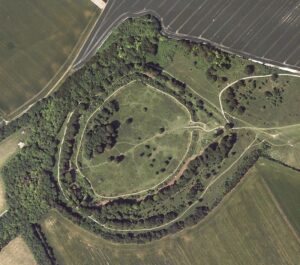
Meeting report
Danebury Hill SSSI is an area that includes the Iron Age hill fort Danebury Ring, which was excavated in the 1970s and dates back to about 500BC. The hill fort consists of concentric rings of mounds and ditches which provide varying topography and aspect. We visited after a prolonged period of sunny and dry weather, but although the sun shone for our excursion, there was a bitter north wind that made us appreciate how exposed this site was.
In true bryological tradition we spent some time exploring the car park, where a number of common species were ticked off, as well as Oxyrrhynchium schleicheri, lurking behind the toilet block on a chalky bank. Water sprays at the ready, we headed off in an anti-clockwise direction along one of the lower paths, through an area of unhappy junipers and some over-vegetated anthills. There was a reasonable selection of epiphytes and common calcicoles such as Hylocomiadelphus triquetrus, Homalothecium lutescens, Fissidens dubius and Neckera complanata. Prolonged searching was rewarded with Seligeria calycina of a few chalk stones. At the base of trees and on chalky banks there was plenty of Ctenidium molluscum, Anomodon viticulosus and Porella platyphylla. But it was hard work, and starting to feel peckish, we took the opportunity for an early lunch.

The search for Campylophyllopsis calcarea
After lunch we headed up to the central area which unfortunately was not as interesting as it was a few years ago and appeared to be under-grazed. Spotting a grove of mature beech trees, Sharon picked up the scent of Campylophyllopsis calcarea and was off. I had been hoping to find this species as the only recent localised records are from the extreme west of the vice-county. A number of small colonies were located, some conspicuous with fruit, looking alarmingly similar to Amblystegium serpens. This is an easy plant to overlook.
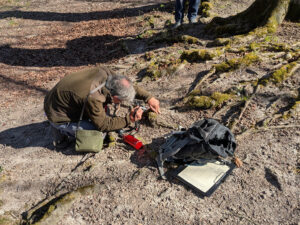
Jonathan Sleath photographing Campylophyllopsis calcarea
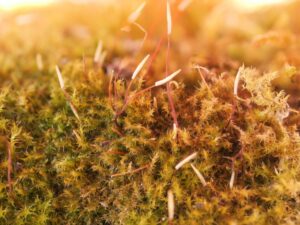
Campylophyllopsis calcarea with capsules
We continued to investigate the chalk grassland which became a little better with a few areas of exposed soil with Weissia brachycarpa var. obliqua, Weissia angustifolia and Bryum radiculosum. In trampled turf near the entrance to the hillfort, Sharon spotted some very sickly Brachythecium glareosum, which seemed to be just about hanging on.
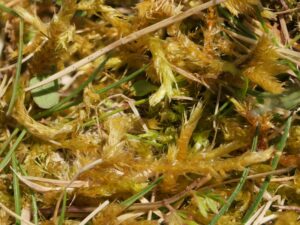
Very sad Brachythecium glareosum
In this area we were able to admire a very splendid wild pear tree in flower, which John Norton identified as Pyrus pyraster.
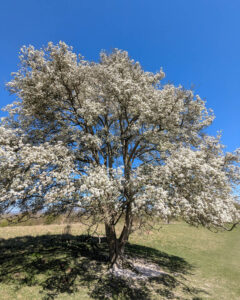
Pyrus pyraster tree at Danebury Hill Fort
Finally, another area of mature beech trees yielded Campylophyllopsis calcarea once again, and we returned to the cars. The site was a little disappointing, and seems to have been richer in the past, but 53 taxa was an acceptable total bearing in mind how dry everywhere was.
Jonathan Sleath
